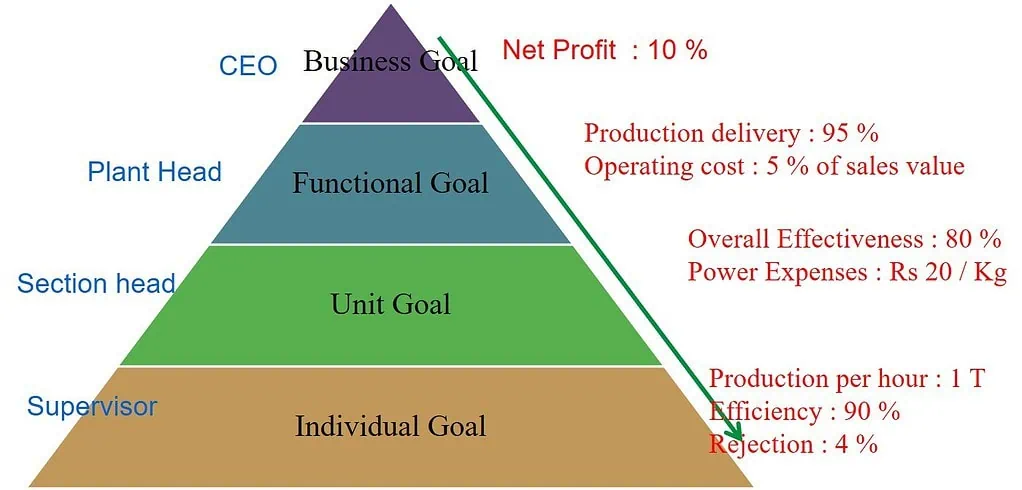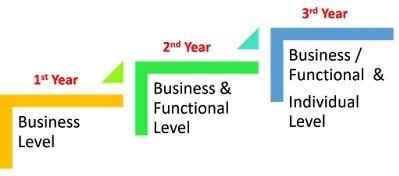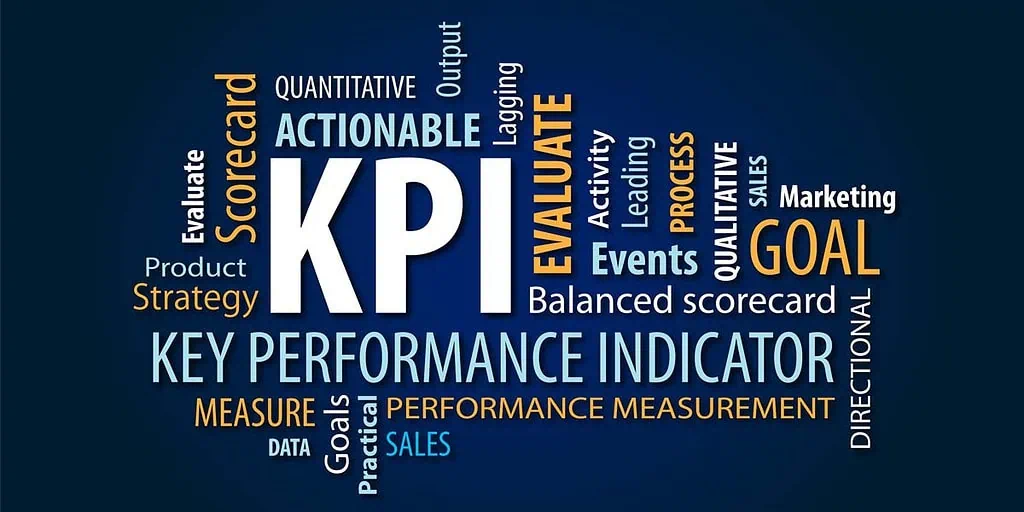Article Contents:
What is meant by KPI or key performance indicator?
KPIs stand for key performance indicators. It is a quantifiable measure of the performance of any objectives.
For example,
One indicator of body health is heart rate, which can be measured as 60 to 100 beats per minute for an average adult. It is considered a key performance indicator of body health. Similarly, other performance indicators, such as blood pressure and sugar level, can also be used to assess the body’s overall health.
Similarly, numerous interactions, activities, and transactions occur within an organization across various functions or the value chain. However, only a few of these activities actually lead to significant performance improvements. This performance can manifest in increased productivity, profitability, sales, or improved morale. Some performances are not negotiable but vital for organizational profitability and growth, and those performances are called key performance indicators (KPIs). That means those performance indicators measure organizational health.
Why are KPIs or Key Performance Indicators essential for business?
Renowned management guru Peter Drucker once said, “What gets measured gets improved.”
Identifying and setting Key Performance Indicators (KPI) targets can help organizations in many ways, such as focusing on important deliverables, bringing people together towards one goal, improving accountability, enhancing communication among stakeholders, knowing the reality against the desired target at any point in time, and taking corrective measures based on the reality versus target.
Although KPIs will vary by industry and organization, most fall under the broad categories of productivity, quality, cost, and delivery.
Examples of KPIs in small Business
In the context of small businesses, an important metric for evaluating operational efficiency is customer delivery performance. Therefore, On-Time Delivery (OTD) is a crucial key performance indicator (KPI) for measuring the efficiency of customer order delivery.
Similarly, the net profit as a percentage of sales is an essential measure of business performance, as it shows the amount of excess cash generated after deducting all expenses.
Typical KPIs for Manufacturing function
I suggest some common key performance indicators (KPIs) for measuring the performance of manufacturing functions.
Please note that this list is for informational purposes only, and you’re free to adjust or add to these KPIs based on your company’s goals and priorities.
S. No | Key performance Indicator | Unit of Measure | Existing Level | Target Level |
1 | % | 20% | 60% | |
2 | Assy time per components | Min/comp | 2 min | 1.5 min |
3 | Total Tonnes produced | Tonnes/ day | 100 T / day | 150 T / day |
4 | Internal rejection over sales | % | 1% | 0.5 % |
5 | Electrical energy consumption | No of units/day | 1000 units | 900 units |
6 | Inventory -WIP over sales | WIP % | 2% | 1% |
7 | Manpower absenteeism | % | 10% | 6% |
8 | 5S score | % | 40 % | 75% |
9 | Process Yield loss | % | 2% | 1% |
10 | Critical spares adherence | % | 40% | 100% |
Typical KPIs for Finance function
I suggest some common key performance indicators (KPIs) for measuring the performance of Finance functions.
Please note that this list is for informational purposes only, and you’re free to adjust or add to these KPIs based on your company’s goals and priorities.
S. No | Key performance Indicator | Unit of Measure | Existing Level | Target Level |
1 | COGS | % | 50 % | 45% |
2 | Net Profitability | % | 12% | 20% |
3 | Outstanding payables> 30 days | Rs | 10 million | 0 |
4 | Outstanding receivables> 30 days | Rs | 5 million | 0 |
5 | Working capital cycle | No of days | 38 days | 28 days |
6 | Statutory compliance | % | 80% | 100% |
7 | Cost saving through projects | Rs | 2 million | 5 million |
8 | Manpower cost | % | 20% | 15% |
9 | Finance cost | % | 2% | 1% |
10 | Inventory as % of sales | % | 10% | 6% |
Typical KPIs for Quality function
I suggest some common key performance indicators (KPIs) for measuring the performance of Quality functions.
Please note that this list is for informational purposes only, and you’re free to adjust or add to these KPIs based on your company’s goals and priorities.
S. No | Key performance Indicator | Unit of Measure | Existing Level | Target Level |
1 | Quality Performance in OEE | % | 80% | 100% |
2 | First pass approval Time | Min/comp | 10 min | 8 min |
3 | Response time for customer complaints | Hours/complaint | 40 Hours | 24 Hours
|
4 | Internal rejection over sales | % | 1% | 0.5 % |
5 | No of SOP was created | No’s / month | 2 | 4 |
6 | No of process -audits/compliance | No’s | 10 / month | 25 / month |
7 | Manpower absenteeism | % | 10% | 6% |
8 | Calibration compliance | % | 40 % | 100%
|
9 | Process Yield loss | % | 2% | 1% |
10 | Cost of poor quality | Rs per product | Rs 350 | Rs 200 |
Typical KPIs for Sales function
I suggest some common key performance indicators (KPIs) for measuring the performance of Sales functions.
Please note that this list is for informational purposes only, and you’re free to adjust or add to these KPIs based on your company’s goals and priorities.
S. No | Key performance Indicator | Unit of Measure | Existing Level | Target Level |
1 | No of new leads generated per month | No’s | 10 | 30 |
2 | No of customer visits per month | No’s / Month | 1 | 5 |
3 | Average response time for quote | Hours/quote | 48 Hours | 24 Hours
|
4 | Query Conversion ratio | % | 2 % | 15 % |
5 | Sales per month | Rs per month | 20 million | 50 million |
6 | No of NEW customer | No’s | One / month | Five / month |
7 | NPD sales | % | 2% | 15% |
8 | Outstanding receivables > 30 days | Rs | 10 million | 0
|
9 | Marketing expenses | % | 12% | 10% |
10 | Average Response time to complaints | Hours | 36 hrs | 24 hrs |
Role of CEO or Business head in implementing performance management
One of the critical responsibilities of a business head or CEO is to set business goals and provide direction. When setting targets, the head should thoroughly prepare and set achievable goals for the team within a given time, resource, and capability. The target should not be unrealistic or aspirational and should not be too lenient with incremental increases, as this may not motivate the team to work effectively.
In many small to medium-sized enterprises (SMEs), we commonly observe that the CEO or business head is not entirely convinced about the target they have set. Despite this, they often push their team to achieve unrealistic targets while expressing pessimism about the team’s ability to meet them, sometimes even setting low targets. This behavior is reflected in the CEO or business head’s communication tone and body language, which can create uncertainty among the team.
“If the CEO or business head sets a target with conviction, they are more likely to achieve it and will do everything in their power to meet it. Their strong belief in the goal will also help them identify and act on opportunities that arise. Furthermore, when the team works towards ambitious goals under visionary leadership, they are motivated to perform their best.”
In one of our client organizations, the CEO had set a production target of 10 tons per day. He was confident in his decision and had the support of his entire team. However, during the financial year, the demand from their existing customer became uncertain, which disrupted his business plan. Despite this setback, he remained committed to his production target of 10 tons per day. He adopted a different approach to secure a new customer and achieve his goal. This achievement boosted his confidence, and it also improved the morale of his team.
Performance management cultivates a culture of solution-oriented and high-performing individuals, providing organizations with a competitive edge.
How can setting targets (KPIs) and review forums boost your business performance?
Let’s discuss the importance of setting and reviewing business targets as a management process to control business performance. As an organization grows from small to large, complexity increases due to more customers, products, people, and other factors. Communication also becomes complicated among all stakeholders. Setting and reviewing targets becomes crucial to overcome this complexity and bring accountability.
The targets can be categorized into Business targets, Functional Targets, and Individual Targets, which are also known as Key Performance Indicators (KPIs). Depending on the size of the organization and the bandwidth to administer the performance management system, the business head can set the targets in the following hierarchy:
- Business Key Performance Indicators
- Functional Key Performance Indicators
- People Key Performance Indicators
It is recommended to start with Business Key Performance Indicators covering all functional deliverables in terms of the following categories:
- Productivity
- Quality
- Cost
- Delivery
- People Engagement
For instance, “Manufacturing cost per component” is one of the key performance indicators under the category of “Cost.” To achieve this KPI target, all functions have to contribute, and the business-level KPI target setting covers all functions.
Once the organization becomes familiar with target setting at the business level and acquires competency, it can move to the next level of target setting at the functional and individual levels.
Business-level KPIs can be set annually and tracked every month, week, and day.
KPI Review Forums & Benefits
After setting up the business KPIs, it’s the responsibility of the business head to organize review forums. These forums are essential for reviewing and discussing the target status with cross-functional team members. Based on the discussion, the team can take counteractions if needed.
The review forum is a fixed agenda meeting with relevant cross-functional team members. Depending on the requirements, it can be conducted monthly, weekly, or daily.
Benefits of KPIs Review forums
First, they provide an excellent opportunity to review the target status and take corrective actions.
Second, when cross-functional team members attend the review forums, they become more accountable.
Third, review forums bring problems to the surface, which can be solved quickly with the team’s help rather than through individual review.
Fourthly, since each cross-functional team member contributes to different KPIs in different roles, the review forum helps the team know each other’s problems and build a stronger bond among the members.
Fifthly, when review forums are conducted properly with a real problem-solving approach, they enhance individual productivity.
When the targets are clear, and the teams are facilitated in achieving them through review forums, the organization eventually adopts a performance management culture. This, in turn, accelerates business performance.
Why is monthly business (KPIs) review important?
The monthly review of key performance indicators (KPIs) examines the previous month’s business and functional performance against the set targets. The objective is to discuss and devise an action plan to enhance business performance in the following month. However, many small and medium enterprise (SME) business leaders do not consistently conduct the monthly review of business performance indicators.
A smart organization sets business and functional key performance indicators (KPIs) at the beginning of each year. The team reviews the progress or status of each KPI every month before the 10th of the month. This helps to monitor performance and ensure that the organization is on track.
Advantages of reviewing KPI’s status along with the team
1. The team is aware of the goal set and status at any point in time
2. The team becomes accountable for results as they are being questioned on their performance every month
3. Ownership and engagement improve as data is shared and communicated to all
4. Helps the organization to improve its performance in the subsequent month. In the absence of monthly KPI reviews, response time would become less (P-D-C-A cycle)
5. When the monthly reviews become a culture, all the functions are keen on data accuracy and timely data sharing. In the absence of monthly routine reviews, data capturing and analysis itself is a significant task for the business head
However, many small and medium enterprise (SME) business leaders do not consistently conduct the monthly review of business performance indicators.
Why some business leaders hesitate to review their KPIs consistently?
Certain beliefs hold them back. Let’s examine them closer to see if we can understand their perspective.
1. As I am spending full time here, I know the P&L trend, and it is not required to conduct reviews with the team
2. The team does not have the time, or no people are capable of collecting and organizing all the data
3. Why should we discuss all the information with the team?
4. Meetings are going to be time wasters as nobody is going to give solutions.
Reexamine your business practices and beliefs about monthly business and functional KPIs and initiate a performance-based culture in your organization!
How do you set KPIs or performance management for your business?

Setting KPIs and targets can be done at the business, functional, and individual levels. However, it is recommended that SMEs begin at the business level and then move on to the functional and individual levels once they become familiar with the performance management system.
To implement a performance management system at the organizational level, SMEs can follow these steps:
- Identify the criteria for measuring the key performance indicators (KPIs). SMEs can classify business objectives into criteria, such as productivity, quality, cost, delivery, and engagement.
- Identify the key performance measurements for each criterion essential to the business. For example, one of the key performance indicators under productivity could be OEE (Overall Equipment Effectiveness) or sales per employee.
- Set a realistic target for each KPI. This target can be based on historical performance or futuristic aspirations.
- Assign people responsibility for each KPI.
- Once targets are fixed for all key performance indicators in each category, track them every month against actual performance.
Step-by-step process in implementing organization-wide performance management system
One of the dreams or visions of most business heads of small, merging organizations is to make the organization system-driven and implement performance-driven management.
As we discussed the need for an organization-wide performance management system, let us learn the step-by-step implementation steps to ensure performance management throughout the organization.

Step1:
Implementing business performance management and keeping the second-level reporters as stakeholders.
Business Level Performance Management:
When an organization is small or is getting into the performance management system for the first time, the logical step is to determine the important business key performance metrics along with some functional key performance metrics and start measuring. Key performance metrics can be measured and tracked by the business heads and their second-level reporters, mainly functional heads.
For example, some of the business KPIs like sales turnover, inventory cost as a % of sales, Plant effectiveness, attrition rate, and % of NPD contribution over sales can be measured and tracked. This set of performance metrics can be reviewed along with functional heads, and they can be encouraged to work on the action plan to improve the business performance.
The duration of implementation of this process can be one year.
Benefits of business-level performance management:
1. The senior leadership team becomes familiar with performance management. Even though they do not feel fully accountable for the results, they feel they are part of the process.
2. Enhances the engagement among functional heads or second-level reporters when the business head reviews along with them every month.
Step 2:
Implementing Business performance management as done in the first year and arriving at suitable functional level performance management, keeping the second level reporters and their team as stakeholders.
Business +Functional Level Performance Management
Since the organization familiarized itself with a business-level performance management system in the first year, it can now have Business performance metrics that can be set by the business head and tracked along with the functional head.
Detailed functional-level performance metrics can be set and assigned to the second or operational head levels. The functional performance parameters can be more functional-oriented, and some business metrics are derived from business KPIs from the business head.
For example, the supply chain function can have more functional metrics, such as the number of vendors developed, inventory levels at different levels, freight cost as a percentage of sales, and so on. Similarly, we can have more functional-level metrics for all functions that can be assigned to respective functional heads and their teams.
The functional heads and teams can be encouraged to present the performance metrics trend and a detailed action plan for the business head every month.
The duration of implementation of this process can be one year.
Benefits of business + functional performance management:
1. The focus will be given in-depth to the functional effectiveness; by the way, measurements are extended to all functional key activities
2. Since we involve functional heads and their team, their involvement and focus are improved on functional effectiveness
3. Most organizations have different functional metrics and performance measurement systems. Eventually, there will be an improvement in the communication process, visibility of issues, and solutions approach, and understanding the pains of cross functions will enhance significantly.
4. Eventually, engagement enhances across functions
Step 3 :
Implementing Individual-level performance metrics, which are derived from business and functional performance metrics
Business Performance Management + Functional Performance Management + Individual Performance Management:
Since the organization familiarized itself with the business performance management system in the first year and the functional team engaged in the functional performance system in the second year, the organization now widens the performance management net to all its people. Ideally, it can be extended to executives and first-line supervisors.
In this process, each individual is given a set of performance metrics that will link with the functional parameters derived from business metrics.
Each individual is accountable for improving their metrics and reporting the progress. The review period can be once every quarter or monthly, depending on the organization’s bandwidth. It is the responsibility of the functional head to review the progress of their team members.
For example, depending on their level in the organization, the individual can be given performance metrics related to their functions. Also, some of the development plans can be added.
By the way, almost the entire organization is governed by performance metrics related to business and functions.
Benefits of organization-wide performance measurement system:
1. Setting the direction for the organization at the business, functional, and individual levels improves focus and engagement.
2. Eventually, the organization gets clarity of performer and non-performer, and this will help to focus on people’s developmental efforts
3. When the rewards and recognitions are based on the performance, it brings visibility, differentiates the performers and non-performers, improves the culture towards self and organizational performance improvement
Overall, performance management brings engagement among people, eases communication, improves focus on results or solutions, and thereby makes culture more about winning than blaming or complaining.
Summary
Implementing the organization-wide performance management system is a long process. It needs to be implemented in a phased manner to sustain the results and involve all the stakeholders to create a performance-based culture!
CEO and leadership team play a vital role in inculcating the performance culture



